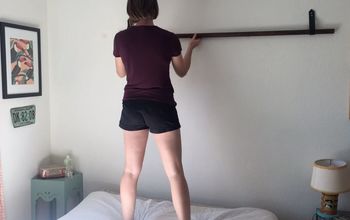How to Fix a Wobbly Ceiling Fan

By Erin Lindholm
When they’re operating properly, ceiling fans are a wonderful fixture in any room. They keep living spaces from feeling stuffy by circulating fresh air. And because it has so many moving parts, it’s not uncommon for a ceiling fan to develop a wobble over time. Luckily, this is typically more of a noise nuisance than it is a serious danger.
So long as you’re comfortable climbing up a ladder to troubleshoot the root cause, it’s relatively easy to fix your ceiling fan from wobbling. All you need is a little know-how, a few tools, and a helping hand. This guide covers everything you need to know about how to fix a wobbly ceiling fan, including steps for identifying what’s causing the wobble and how to fix it with common household tools.
Photo via Karen's Up on The Hill
Why Your Ceiling Fan Is Wobbly
There are a few common culprits for why a ceiling fan develops a wobble over time. The issue is likely an imbalance on one of the blades or the fan may need adjustments where it’s attached to the ceiling—which could mean anything from tightening a few screws to correcting how the fan’s base was installed. (We’ll get to that below.)
An ever-so-slight wobble is totally normal. But anything greater than a barely-there wobble (think ⅛- to ¼-inch movement) is an indication that something’s loose or imbalanced. Your ceiling fan wobbles because of one or more of these scenarios:
- A few screws need to be tightened
- Dust has weighted down the blades or clogged the motor
- One or more of your ceiling fan blades are warped or bent
- The ceiling fan was incorrectly mounted
Determining the cause of the wobble involves a systematic check of the ceiling fan’s components, which is a lot easier than it sounds. So grab your ladder and a willing helper, and follow this step-by-step troubleshooting guide to get your ceiling fan running smoothly again.
Photo via Shutterstock
How to Fix a Wobbly Ceiling Fan
Fix your ceiling fan from wobbling with these simple steps and checks. You’ll be glad you did!
Step 1: Disconnect Power
Anytime you’re working on a home project that involves electrical components and/or wiring, it’s always important to cut the power to what you’re working on. Just flip the switch on the electrical breaker panel that powers that room of your home.
Step 2: Deep Clean
Believe it or not, it’s possible that the weight of dust accumulation on a ceiling fan’s blades might be the cause of the wobble. Give your ceiling fan a deep clean by dusting the fan blades with an extended-reach duster and spraying compressed air to remove any dust potentially lodged in the fan’s motor.
Pause here to turn the power back on and run the fan at various speeds for a few minutes to see if simply giving the fan a deep clean resolved the wobble and noise. If the fan's still wobbling, turn off the power again and proceed to the next step.
Step 3: Check the Mount
If your fan is suspended from the ceiling, gently test to see if the fan easily moves side to side. If it does, tighten the support screws on the top portion of the fan casing. If any of these screws tightened under your grip, run another test of the fan before proceeding. Remove the canopy (the round metal piece that covers the ceiling fan’s mechanical components) and firmly tighten the screws underneath that are securing the fan mount to the ceiling.
Grab a Buddy
Step 4: Inspect Electrical Components
While you have the ceiling fan’s electrical parts in view, look for labeling indicating what type of electrical box was used on the installation. Standard building code requires that ceiling fans are supported by a round ceiling fan-rated electrical box (also known as a junction box), which is attached with heavy-duty lag bolts or U-bolts to a structural stud or rafter and can support the weight load of a ceiling fan.
There are safe alternatives—which you’ll see in older homes—but what you don’t want to find is a shoddy install job with an electrical box meant for lighter-weight figures, which isn't properly mounted to a structural stud or rafter. If you have any concerns about how the ceiling fan was installed in the first place, it’s a good idea to call in a professional to review.
Once you’ve assessed and tightened all support screws, and confirmed the ceiling fan’s mounted mechanical components were safely installed to begin with, it’s time to replace the fan canopy and run another test of the fan’s operation. With any luck, your wobble is resolved!
Step 5: Check Blades
If the wobble still persists, it’s time to inspect the fan blades. Back up on the ladder and tighten all screws that hold the blades to the main motor housing of the ceiling fan. Then, measure the vertical distance from the end tip of each fan blade to the ceiling. The measurements should be ballpark consistent, and if you’ve found an outlier, that fan blade could very likely be the source of your wobble.
Step 6: Balance Blades
With as much rotation as a ceiling fan’s blades have over time, it’s understandable that ceiling fan blades are stressed from general aging or high fluctuations in temperature and humidity throughout the year. Installing a ceiling fan balancing kit on the blades themselves corrects any noises that aren’t mechanical (or install) related.
Penny Tips
Tips and Hacks for Difficult Cases
If you’ve tried the steps above to fix your ceiling fan to no avail, it’s likely a mechanical issue—especially if the fan is over ten years old. At this point, it’s probably best to invest in a new ceiling fan.
Have you fixed a wobbly ceiling fan before? We’d love to know more in the comments below!
Enjoyed the project?
Comments
Join the conversation
-
-
 Debra Russell
on May 09, 2022
Debra Russell
on May 09, 2022
that's really good thank you for sharing myfiosgateway.com
-

























Frequently asked questions
Have a question about this project?